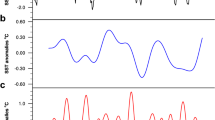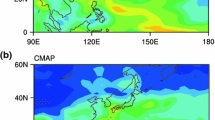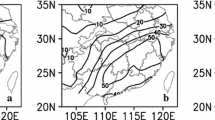Abstract
It is well known that the Sahel region of Africa is impacted by decadal scale variability in precipitation, driven by global sea surface temperatures. This work demonstrates that the National Center for Atmospheric Research’s Community Atmosphere Model, version 4 is capable of reproducing relationships between Sahelian precipitation variability and Indian and Atlantic Ocean sea surface temperature variations on such timescales. Further analysis then constructs a moisture budget breakdown using model output and shows that the change in precipitation minus evaporation in the region is dominated by column integrated moisture convergence due to the mean flow, with the convergence of mass in the atmospheric column mainly responsible. It is concluded that the oceanic forcing of atmospheric mass convergence and divergence to a first order explains the moisture balance patterns in the region. In particular, the anomalous circulation patterns, including net moisture divergence by the mean and transient flows combined with negative moisture advection, together explain the drying of the Sahel during the second half of the twentieth century. Diagnosis of moisture budget and circulation components within the main rainbelt and along the monsoon margins show that changes to the mass convergence are related to the magnitude of precipitation that falls in the region, while the advection of dry air is associated with the maximum latitudinal extent of precipitation.












Similar content being viewed by others
References
Ali A, Lebel T (2009) The Sahelian standardized rainfall index revisited. Int J Climatol 29:1705–1714
Bader J, Latif M (2003) The impact of decadal-scale Indian Ocean sea surface temperature anomalies on Sahelian rainfall and the North Atlantic oscillation. Geophys Res Lett 30(22):2169. doi:10.1029/2003GL018426
Biasutti M (2013) Forced Sahel rainfall trends in the CMIP5 archive. J Geophys Res 118:1613. doi:10.1002/jgrd.50206
Biasutti M, Sobel AH, Camargo SJ (2009) The role of the Sahara Low in summertime Sahel Rainfall variability and change in the CMIP3 models. J Clim 22:5755–5771
Bretherton CS, Smith C, Wallace JM (1992) An intercomparison of methods for finding coupled patterns in climate data. J Clim 5:541–560
Brubaker KL, Entekhabi A, Eagleson PS (1993) Estimation of continental precipitation recycling. J Clim 6:1077–1089
Caminade C, Terray L (2010) Twentieth century Sahel rainfall variability as simulated by the ARPEGE AGCM, and future changes. Clim Dyn 35:75–94
Charney J (1975) Dynamics of deserts and drought in the Sahel. Q J R Meteorol Soc 101:193–202
Cook KH, Meehl GA, Arblaster JM (2012) Monsoon Regimes and Processes in CCSM4. Part II: African and American monsoon systems. J Clim 25:2609–2621
Folland CK, Palmer TN, Parker DE (1986) Sahel rainfall and worldwide sea temperatures, 1901–1985. Nature 320:602–607
Fontaine B, Louvet S, Roucou P (2008) Definition and predictability of an OLR-based West African monsoon onset. Int J Climatol 28:1787–1798
Gent et al (2011) The community climate system model version 4. J Clim 24:4973–4991
Giannini A, Saravanan R, Chang P (2003) Oceanic forcing of Sahel rainfall on interannual to interdecadal time scales. Science 302:1027–1030
Giannini A, Saravanan R, Chang P (2005) Dynamics of the boreal summer African monsoon in the NSIPP1 atmospheric model. Clim Dyn 25:517–535
Grist JP, Nicholson SE (2001) A study of the dynamic factors influencing the rainfall variability in the West African Sahel. J Clim 14:1337–1359
Hagos SM, Cook KH (2007) Dynamics of the West African monsoon jump. J Clim 20:5264–5284
Hagos SM, Cook KH (2008) Ocean warming and late-twentieth-century Sahel drought and recovery. J Clim 21:3797–3814
Hagos SM, Zhang C (2010) Diabatic heating, divergent circulation and moisture transport in the African monsoon system. Q J R Meteorol Soc 136:411–425
Hoerling M, Hurrell J, Eischeid J, Phillips A (2006) Detection and attribution of twentieth-century Northern and Southern African rainfall change. J Clim 19:3989–4008
Janowiak J, Grubber A, Kondragunta CR, Livezey R, Huffman G (1998) A comparison of the NCEP/NCAR reanalysis precipitation and the GPCP raingauge-satellite combined dataset with observational error considerations. J Clim 11:2960–2979
Kalnay E et al (1996) The NCEP/NCAR 40-year reanalysis project. Bull Am Meteorol Soc 77:437–471
Kintner JL-III, Fennessy MJ, Krishnamurthy V, Marx L (2004) An evaluation of the apparent interdecadal shift in the tropical divergent circulation in the NCEP-NCAR reanalysis. J Clim 17:349–361
Lu J (2009) The dynamics of the Indian Ocean sea surface temperature forcing of Sahel drought. Clim Dyn 33:445–460
Lu J, Delworth TL (2005) Oceanic forcing of the late 20th Century Sahel drought. Geophys Res Lett 32:22706. doi:10.1029/2005GL023316
Mitchell T, Jones P (2005) An improved method of constructing a database of monthly climate observations and associated high-resolution grids. Int J Clim 25:693–712
Nicholson SE (2000) The nature of rainfall variability over Africa on time scales of decades to millennia. Glob Plan Change 26:137–158
Nicholson SE (2005) On the question of the “recovery” of the rains in the West African Sahel. J Arid Environ 63:615–641
Nicholson SE, Webster PJ (2007) A physical basis for the interannual variability of rainfall in the Sahel. Q J R Meteorol Soc 133:2065–2087
Otto-Bliesner B (1999) El Nino/La Nina and Sahel precipitation during the middle Holocene. Geophys Res Lett 26:87–90
Palmer TN (1986) Influence of the Atlantic, Pacific, and Indian Oceans on Sahel rainfall. Nature 322:251–253
Poccard I, Janicot S, Camberlin P (2000) Comparison of rainfall structures between NCEP/NCAR reanalyses and observed data over tropical Africa. Clim Dyn 16:897–915
Rayner NA, Parker DE, Horton EB, Folland CK, Alexander LV, Rowell DP, Kent EC, Kaplan A (2003) Global analyses of sea surface temperature, sea ice, and night marine air temperature since the late nineteenth century. J Geophys Res 108(D14):4407. doi:10.1029/2002JD002670
Rowell DP, Folland CK, Maskell K, Ward MN (1995) Variability of summer rainfall over tropical north Africa (1906–92): observations and Modelling. Q J R Meteorol Soc 121:669–704
Salack S, Muller B, Gaye AT (2011) Rain-based factors of high agricultural impacts over Senegal. Part I: integration of local to sub-regional trends and variability. Theor Appl Climatol 106:1–22
Seager R, Henderson N (2013) Diagnostic computation of moisture budgets in the ERA-interim reanalysis with reference to analysis of CMIP-archived atmospheric model data. J Cim 26:7876–7901
Seager R, Naik N, Vecchi GA (2010) Thermodynamic and dynamic mechanisms for large-scale changes in the hydrological cycle in response to global warming. J Clim 23:4651–4668
Seager R, Pederson N, Kushnir Y, Nakamura J (2012) The 1960s drought and the subsequent shift to a wetter climate in the catskill mountains region of the New York City watershed. J Clim 25:6721–6742
Shanahan TM, Overpeck JT, Anchukaitis KJ, Beck JW, Cole JE, Dettman DL, Peck JA, Scholz CA, King JW (2009) Atlantic forcing of persistent drought in West Africa. Science 324:377–380
Su H, Neelin JD (2005) Dynamical mechanisms for African monsoon changes during the mid-Holocene. J Geophys Res 110:D19105. doi:10.1029/2005JD005806
Taylor CM, Lambin EF, Stephenne N, Harding RJ, Essery RL (2002) The influence of land use change on climate in the Sahel. J Clim 15:3615–3629
Trenberth KE, Guillemot CJ (1995) Evaluation of the global atmospheric moisture budget as seen from analysis. J Clim 8:2255–2272
Trenberth KE, Dai A, Rasmussen RM, Parsons DB (2003) The changing character of precipitation. Bull Am Meteorol Soc 84:1205–1217
Uppala SM et al (2005) The ERA-40 re-analysis. Q J R Meteorol Soc 131:2961–3012
Zeng N, Neelin JD, Lau K-M, Tucker CJ (1999) Enhancement of interdecadal climate variability in the Sahel by vegetation interaction. Science 286:1537–1540
Acknowledgments
The authors would like to thank Dr. Jennifer Nakamura for providing assistance with data analysis as well as Drs. Naomi Henderson, Haibo Liu, and Richard Seager and the Global Decadal Hydroclimate Predictability, Variability, and Change (GloDecH) group with its support through the National Oceanic and Atmospheric Association (NOAA) for useful discussions and completion of the model runs. CP would also like to thank the National Science Foundation for funding through the Graduate Research Fellowship Program and Etienne Dunn-Sigouin for assistance with programming. Finally, we thank the editor and an anonymous reviewer for providing useful comments that improved this study.
Author information
Authors and Affiliations
Corresponding author
Appendix
Appendix
Figure 3 from the manuscript clearly shows the overestimation of rainfall variability in the NCEP/NCAR Reanalysis when compared to the observations or CAM4 modeled precipitation. It is further shown here that this discrepancy is due to the overestimation of the variance in the precipitation field prior to 1968 (Fig. 13a), and that it is much more realistic afterwards (Fig. 13b).
Given the documented discrepancies in the variability of the NCEP/NCAR Reanalysis data (Poccard et al. 2000; Kintner et al. 2004), an alternative method to utilize the moisture budget of this dataset would be to compute the precipitation as a summation of the column integrated moisture flux and the evaporation, as explained in the text. However, a quick glance at Fig. 14 clearly shows that virtually all moisture budget variables through time (1901–2008, unfiltered) seem to show the same discrepancies as the previous studies have indicated. These include surface evaporation (in W/m2), total column precipitable water (in kq/m2), specific humidity (at 925, 600, and 300 mb and unitless), and zonal and meridional wind velocity (at 925, 600, and 300 mb in m/s). In virtually all cases, not just limited to precipitation and wind fields as documented by previous works, but also with evaporation, specific humidity, and total column precipitable water, the troubling drop off in magnitude and variability is apparent (note the differences in scale among the various panels). All variables reveal similar patterns to the NCEP/NCAR Reanalysis generated spurious precipitation field (Fig. 14a). There is a huge dropoff in the magnitude of all the study variables around 1968, with concurrent decreases in all moisture budget terms’ variability. This brief exploratory analysis, along with the results of previous works, leads us to conclude that studying regional variations in Sahel rainfall previous to 1968 cannot be done accurately using the NCEP/NCAR Reanalysis fields, even if the precipitation is computed as a residual of other variables’ due to their apparent shortcomings as well. This finding further encourages us to use the SST-driven model to understand the twentieth century moisture budget and its variability.
NCEP/NCAR Reanalysis variables averaged over the Sahel domain for JAS 1901–2008. a Precipitation, including UEA observations (red line), b evaporation, c precipitable water, d–f specific humidity at 925, 600, and 300 mb, g–i zonal wind at 925, 600, and 150 mb, and j–l meridional wind at 925, 600, and 150 mb. Scales differ among all plots
Rights and permissions
About this article
Cite this article
Pomposi, C., Kushnir, Y. & Giannini, A. Moisture budget analysis of SST-driven decadal Sahel precipitation variability in the twentieth century. Clim Dyn 44, 3303–3321 (2015). https://doi.org/10.1007/s00382-014-2382-3
Received:
Accepted:
Published:
Issue Date:
DOI: https://doi.org/10.1007/s00382-014-2382-3






